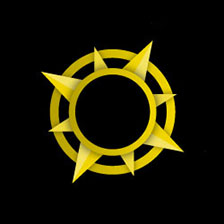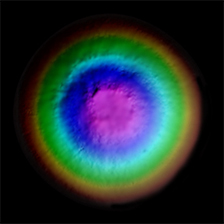Lunar Map Projections and Grid Reference System for Artemis Astronaut Surface Navigation
- Primary Authors
- McClernan, M.T., Dennis, M.L., Theriot, I.H., Hare, T.M., Archinal, B.A., Ostrach, L.R., Hunter., M.A., Miller, M.J., Beyer, R.A., Annex, A.M., Lawrence, S.J.
- Originators
- USGS Astrogeology Science Center
- Publisher
- USGS Astrogeology Science Center
- Publication Date
- 2024-09-20
- Abstract
- USGS is assessing the feasibility of map projections and grid systems for lunar surface operations. USGS has proposed the development of a new Lunar Transverse Mercator (LTM) and Lunar Polar Stereographic (LPS) system to support the Lunar Grid Reference System (LGRS) a new grid system designed to support crewed Artemis mission navigation. Additionally, a way of simplifying the LGRS coordinate structure was also designed for crew navigation and is referred to as LGRS in Artemis Condensed Coordinates (ACC) format. Data related to ACC is expected to be released at a later date. LTM, LPS, and LGRS are similar in design and use to the Universal Transverse Mercator (UTM), Universal Polar Stereographic (LPS), and Military Grid Reference Systems (MGRS), but adhere to NASA requirements. Description: The Lunar Transverse Mercator (LTM) projection system is a globalized set of lunar map projections that divides the Moon into zones to provide a uniform coordinate system for accurate spatial representation. It uses a transverse Mercator projection, which maps the globe in narrow vertical strips on the surface of a horizontal cylinder, reducing distortion within each zone. The LTM system divides the Moon into 45 transverse Mercator stirps, each 8° degrees of longitude wide. When these strips are subdivided at the lunar equator for a total of 90 zones. Forty-five in the northern hemisphere and forty-five in the south. and specifies a topocentric, rectangular, coordinate system (easting and northing) for spatial referencing. This projection is commonly used in GIS and surveying for its ability to represent large areas with high positional accuracy, while maintaining consistent scale across regions. LTM was designed similarly to its UTM counterpart (NGA, 2014) but adheres to NASA specifications of scale-error (McClernan, 2023). The specifications to the LTM system are described below. Request McClernan (in-press) for more detail. The Lunar Polar Stereographic (LPS) projection system contains projection specifications for the Moon’s polar regions. It uses a polar stereographic projection, which maps the polar regions onto an azimuthal plane. Though distortion is modeled for each LPS zone, generally polar regions express a larger scale-error then their terrestrial counterparts. The LPS system projects the Moon polar regions into 2 zones, each zone is located in either the northern or southern hemisphere and is referred to as the LPS northern or LPS southern zone. LPS, like its equatorial counterpart LTM, specifies a topocentric, rectangular, coordinate system (easting and northing) for spatial referencing. This projection is commonly used in GIS and surveying for its ability to represent large polar areas with high positional accuracy while maintaining consistent scale across the map region. LPS is designed similarly to UPS, its terrestrial counterpart, with minimal changes (NGA, 2014) but adheres to NASA specifications (McClernan, 2023). The specifications to the LPS system are described below. Request McClernan et. al. (in-press) for more detail. LGRS is a globalized grid system for lunar navigation supported by the LTM and LPS projections. LGRS provides an alphanumeric grid coordinate structure for both the LTM and LPS systems. This labeling structure is utilized in a similar manner to MGRS (NGA, 2014). The LGRS grid is defined to be a 25×25 km square area and is dimensioned based on the coordinate values of LTM and LPS. Two implementations of LGRS 25 km grid were defined as polar areas require a a LPS projection. All other areas utilize the LTM system projections. We describe the difference between the grid labeling structure between the LTM and LPS portions in the following sections. The transformation occurring between the lunar surface and the map surface imposes a linear distortion across the map where distances are shifted. This is often referred to as the grid-to-ground problem and is commonly addressed in terrestrial plane surveying as the measurement of distance is impacted. The effect of linear distortion is a shift in distance. Distances measured from the map grid are either expanded or contracted when represented on the ground surface. The shift is influenced by lunar elevation and the map's scale factor. While linear distortion cannot be eliminated it can be calculated and calibrations can be applied for accurate mapping and spatial analysis. The contents of this data release are the LTM map projections scale factor, the height factor in the LTM portions of the Moon, and the combined factor, accounting for both the map scale factor and the variation imposed from elevation. Reference Publication McClernan, M.T., Dennis, M.L., Theriot, I.H., Hare, T.M., Archinal, B.A., Ostrach, L.R., Hunter., M.A., Miller, M.J., Beyer, R.A., Annex, A.M., and Lawrence, S.J., in-press, Lunar Grid Systems, Transverse Mercator and Polar Stereographic Systems, and Map Projections for the Artemis Missions and Lunar Surface Navigation, U.S. Geological Survey Techniques and Methods TBD, Version 1, doi:10.5066/P1SZQZDB. References Archinal, B. A., Acton, C. H., A’Hearn, M. F., Conrad, A., Consolmagno, G. J., Duxbury, T., Hestroffer, D., Hilton, J. L., Kirk, R., Klioner, S. A., McCarthy, D., Meech, K., Oberst, J., Ping, J., Seidelmann, P. K., Tholen, D. J., Thomas, P. C., and Williams, I. P., 2018, Report of the IAU Working Group on Cartographic Coordinates and Rotational Elements: 2015: Celestial Mechanics and Dynamical Astronomy, v. 130, no. 22, 46 p., doi:10.1007/s10569-017-9805-5. Reprint available at https://astropedia.astrogeology.usgs.gov/download/Docs/WGCCRE/WGCCRE2015reprint.pdf. Dennis, M.L., 2023, The Future is Here: Introducing the State Plane Coordinate System of 2022, in: Proc. of FIG (International Federation of Surveyors) Working Week, Orlando, Florida, U.S.A., 15 p., proceedings (accessed March 2024). Karney, C.F.F., 2010, transverse Mercator with an accuracy of a few nanometers: Journal of Geodesy, v. 85, no. 8, p. 475–485, doi:10.1007/s00190-011-0445-3. Kinsler, D.K., 1975, User Guide To 1:250,000 Scale Lunar Maps, Lunar Science Institute Contribution No. 206 No. 206, https://core.ac.uk/download/pdf/222788082.pdf. Krüger, L., 1912 Konforme Abbildung des Erdellipsoids in der Ebene (Conformal mapping of the ellipsoidal earth to the plane): Royal Prussian Geodetic Institute, New Series v. 52, 172 p., doi:10.2312/GFZ.b103-krueger28. McClernan, M.T., Archinal, B.A., Skinner, J.A., and Buban, H.C. (2023) Proposed Geographic Coordinate System for Lunar Surface Navigation and The Artemis missions: Abstract (7023), presented at the 6th Planetary Data Workshop, Flagstaff, AZ, July 2023, 2 p., https://www.hou. usra.edu/meetings/planetdata2023/pdf/7023.pdf. NGA, 2014, The Universal Grids and the transverse Mercator and Polar Stereographic Map Projections: National Geospatial-Intelligence Agency (NGA) Standardization Document, NGA.SIG.0012_2.0.0_UTMUPS., 86 p. Snyder, J.P. 1987, Map Projections – A working Manual: US Geologic Survey Professional Paper 1395. Washington, DC: US Government Printing Office, 397 p.
- Purpose
- The Artemis Geospatial Data Team (AGDT) has tasked USGS Astrogeology to develop a navigational grid and associated Projected Coordinate Reference Systems (PCRS) optimized for lunar navigation. The Data Team has specified the PCRSs must have a specified map scale error and the grid must be high precision utilizing a limited number of coordinate characters. This page introduces the map projections utilized in Lunar equatorial regions employed by the LTM system, the associated linear map distortions, and Equatorial LGRS Grids for human navigation.
Contact and Distribution
- Format
- Archive, Grids, Vector Data
- Access Constraints
- None
- Access Scope
- Astropedia
- Use Constraints
- Please site author
- Astrogeology Theme
- Cartography, Geographic Information System (GIS), Photogrammetry
- Mission Names
- Artemis
- Digital Product?
- yes
- Online Package Link
- https://astrogeology.usgs.gov/search/map//lunar-map-projections-and-grid-reference-system-for-artemis-astronaut-surface-navigation
- External File Size
- 12.5G
- Online File Link
- https://www.sciencebase.gov/catalog/item/667b1061d34e6151c9d6bcc7
- Currentness Reference
- Ground condition
- Progress
- Complete
- Update Frequency
- As needed
- Logical Consistency
- Grid spacing validating in QGIS. Data was processed and created without GIS software thus validating it.
- Process Description
- Shapefile written using standard map projections to the specified grid spacing
Lineage
- Process Date
- 2024-09-17
- Attribute Accuracy Report
- Accuracy based on JPL DE 421
Geospatial Information
- Target
- Moon
- System
- Earth
- Map Projection Name
- Mercator, Polar Stereographic, Transverse Mercator


















